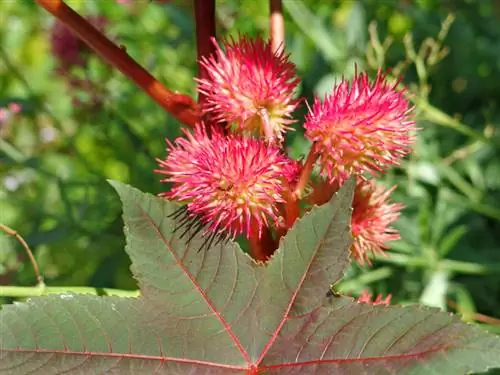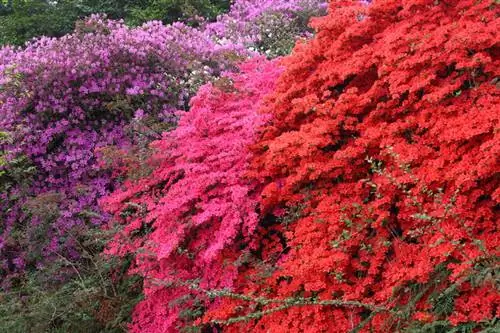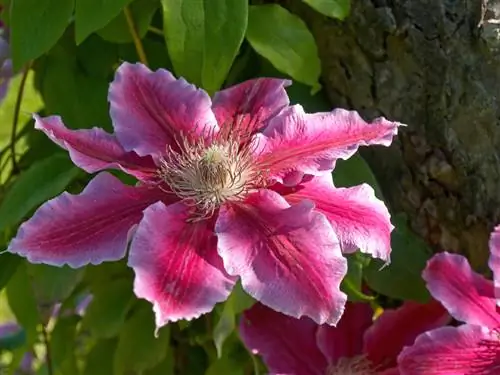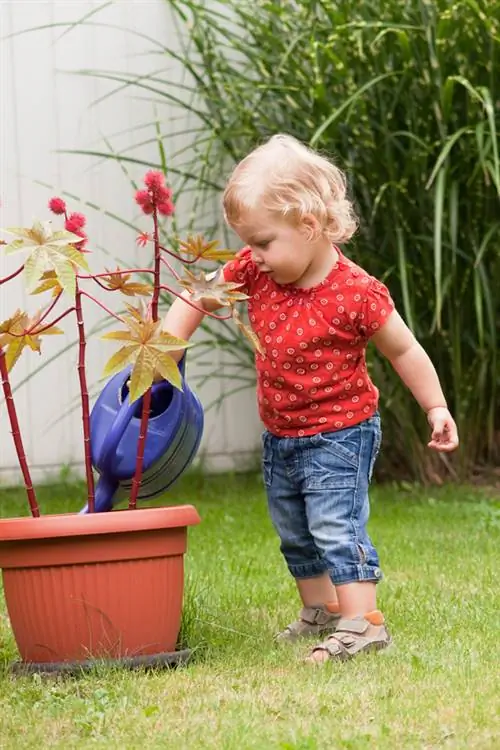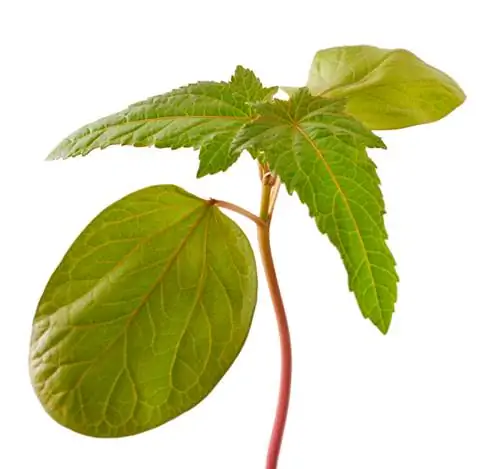- Author admin [email protected].
- Public 2023-12-25 17:45.
- Last modified 2025-01-23 11:20.
The castor bean plant impresses with its phenomenal appearance, rapid growth, huge leaves and bright red fruits. When the fluffy flowers are followed by the spectacular prickly fruits, we can no longer escape the magical radiance. Nevertheless, the miracle tree poses a life-threatening danger due to the poisonous contents of its seeds. The following answers to frequently asked questions explain in detail how to deal with this and cultivate a majestic plant.
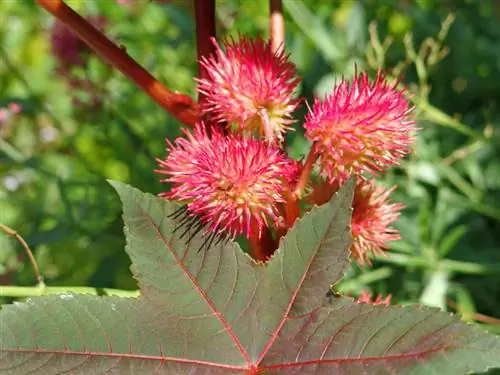
How to grow castor bean plants safely?
The castor bean (Ricinus communis) is an impressive plant with large leaves and bright red fruits. Its seeds contain the highly toxic protein ricin. To cultivate the plant safely, plant it out of the reach of children and animals, remove seeds in a timely manner, and wear protective clothing during care and planting work.
Planting castor bean correctly
The miracle tree is extremely sensitive to cold. Plant the plant you have grown yourself or purchased ready-made in the bed from mid/late May at the earliest. To do this, choose a sunny location with nutritious, fresh, moist soil. Beforehand, immerse the potted root ball in water until no more air bubbles appear. Meanwhile, dig a spacious pit to enrich the soil with compost and horn shavings. Then pot up the Ricinus communis and plant it in the middle so deeply that the previous planting depth is maintained. Water generously and continue the constant water supply so that the rooting progresses unhindered.read more
Care tips
As long as you pay enough attention to the highly poisonous status of a Ricinus communis, the care program does not pose any particular challenges. The main premise is that the majestic miracle tree shows great thirst and enormous hunger. How to do it right:
- Water thoroughly as soon as the soil has dried out
- Fertilize organically or mineral-organically from May to September
- In autumn, cut off the plant parts close to the ground if overwintering takes place
- Heap up bedding plants thickly with straw, leaves, compost and brushwood
- Put potted plants in bright winter quarters with temperatures of 8-10 degrees Celsius
Since the miracle tree can be easily propagated by sowing, the effort involved in overwintering only makes sense in mild wine-growing regions.
Which location is suitable?
The miracle tree favors a sunny, warm and protected location on the balcony. In regions with mild winters, the castor bean plant thrives in beds with nutrient-rich, loose, humus-rich and fresh, moist soil. A sunny spot in front of mighty trees that can absorb strong winds is ideal so that the herbaceous plant is not knocked over.
What soil does the plant need?
The breathtaking growth and enormous biomass of a castor bean plant require nutrient-rich and humus-rich soil. The soil should be fresh, moist, well-drained and not at risk of waterlogging. For cultivation in a bucket, we recommend using a high-quality, structurally stable, compost-based substrate with a low peat content.
When is flowering time?
The miracle tree puts on its blossoms from July to October. Mighty flower spikes rise above the fingered leaves. The arrangement of the flowers is characteristic of the castor bean. Only male flowers grow in the lower part, whose job it is to fertilize the female flowers in the upper part with the help of insects. The bright red fruits can therefore always be discovered in the upper region.
Cut castor bean correctly
Before winter, only cut the herbaceous plant close to the ground when all the leaves have fallen. Then cover the root ball in the bed with leaves and brushwood. You can then move a miracle tree in a pot into its bright, frost-free winter quarters. Whether it's worth it given how easy it is to sow is up to your individual decision.
Pouring castor oil
As soon as the surface of the earth has dried, a miracle tree is watered. Let the water run until it runs out of the bottom opening. During hot summer days, this measure may be necessary daily. Water your castor bean preferably in the early morning or late evening.
Fertilize castor bean correctly
You can fertilize a miracle tree weekly from May to September with standard liquid fertilizer (€9.00 on Amazon). If this is too time-consuming for you, apply a mineral-organic long-term fertilizer as sticks, cones or granules according to the manufacturer's instructions. Add mature compost with horn shavings to the bed. Work the material in superficially and pour more.
Wintering
If your garden is in a wine-growing region with mild winters, there are good prospects of successful wintering. After the miracle tree has drawn in its above-ground plant parts in autumn, cover the root ball 20-30 cm high with leaves, straw and coniferous twigs. Before the first frost, a castor bean in a pot moves to a bright winter quarters with temperatures between 8 and 10 degrees Celsius. Beforehand, cut the plant close to the ground. During the cold season, water every now and then to prevent the root ball from drying out.read more
Propagate castor beans
Sowing seeds has proven to be an uncomplicated method of propagation in the hobby garden. How to do it right:
- The best time for sowing is in March and April
- Put on suitable protective clothing and gloves
- Fill nutritious soil into 12 cm pots
- Press 2-3 seeds into the substrate and water
- In a partially shaded window seat, germination begins within 14 days at 20 degrees Celsius
Until mid-May, repot the young plants whenever the previous pot becomes too narrow. Keep the substrate constantly moist and start applying diluted liquid fertilizer from the end of April.
Castor in a pot
On the sunny balcony, the miracle tree thrives in a large pot with high-quality compost-based potted plant soil. A few shards of pottery or pebbles above the floor opening prevent waterlogging from occurring. Water abundantly and regularly, as drought results in stunted growth. The same applies to nutrient supply. From May to September, treat the castor bean with liquid fertilizer every week. Overwintering is possible in bright, frost-free winter quarters. Cut off the above-ground parts of the plant and only water enough to prevent the root ball from drying out.
Is castor bean poisonous?
The miracle tree harbors a deadly danger in its seeds. The prickly fruits are full of ricin, a highly toxic protein. Even the tiny amount of 0.25 milligrams can be fatal. Fatal circulatory failure sets in no later than 48 hours after consumption. An antidote is not yet available. How to handle the life-threatening potential:
- Plant the miracle tree out of the reach of children and animals
- For reasons of caution, remove the seeds in good time and dispose of them in the hazardous waste
- Store seeds intended for sowing safely
- Put on suitable protective clothing for care and planting work
Furthermore, the production of castor oil, which is known as a medicinal product, as a laxative should only be left in professional hands.
Trivia
The toxic protein contained in the seeds of the castor bean plant is so dangerous that it is classified as a weapon of mass destruction. As a result, ricin is subject to the United Nations Chemical Weapons Convention. This circumstance is primarily based on the fact that even tiny amounts of the seeds have a lethal effect without an antidote being available.
Beautiful varieties
- Carmencita: Majestic variety with shiny, brown-red leaves and bright fruits from October
- Apache: With a height of 100 cm, this miracle tree is ideal for cultivation in a container
- Sanguineus: The variety impresses with dark brown foliage on red stems and red fruits in autumn
- Unguja Green: A rare Ricinus communis with solid green leaves and cream-colored flowers from July
- Zanzibariensis: This miracle tree produces the largest leaves among fiery red fruit clusters

